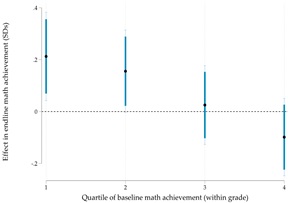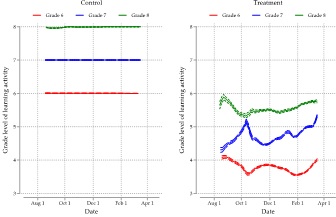Which Students Benefit from Computer-Based Individualized Instruction? Experimental Evidence from Public Schools in India
Does computer-based individualized instruction boost math learning?
Yes. In public schools in Rajasthan, India, students who scored in the bottom 25% of their class improved by 22% of a standard deviation in math test scores (top chart). However, the average student in grades 6-8 who had access to individualized instruction did not outperform those who did not over nine months. Our results suggest that computer-based individualized instruction is most beneficial for low performers.
What is computer-based individualized instruction?
We provided all students with a computer-adaptive math learning software called “Mindspark.” When students first log in, they take a diagnostic test, which identifies what they know and can do, and the areas in which they can improve. Then, the software presents them with exercises appropriate for their preparation level based on the diagnostic test. The difficulty and topic covered by subsequent exercises dynamically adjust to each student’s progress.

How to read this chart: This chart shows that, over nine months, computer-based individualized instruction caused those students who started in the bottom half of their grade level’s math achievement to learn more. Those students in the top half did not see a positive impact.

How to read this chart: This chart shows that students in the control group received grade-level material, whereas students in the treatment group received materials that matched their individual performance levels.
How did we do this study?
We conducted an experimental study that meets Tier 1 of the Every Student Succeeds Act (ESSA) evidence standards. We randomly assigned students to receive or not receive individualized instruction for nine months (bottom chart). Given that the only thing that distinguishes those who received individualized instruction from the ones that did not is chance, any differences in learning between them can be attributed to such instruction and not to other factors. The sample included 1,528 public school students in grades 6-8. We measured math ability at the start and end of the study using paper-based assessments.
Full Article Citation:
Andreas de Barros & Alejandro J. Ganimian (2023). Which Students Benefit from Computer-Based Individualized Instruction? Experimental Evidence from Public Schools in India. Journal of Research on Educational Effectiveness, DOI: 10.1080/19345747.2023.2191604.
de-Barros-Ganimian-2023-04-04-final.pdf
